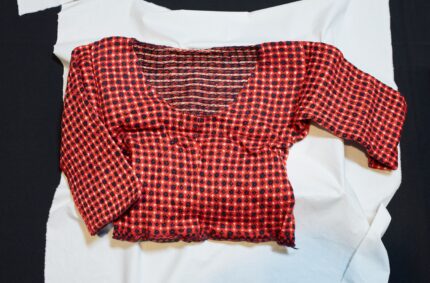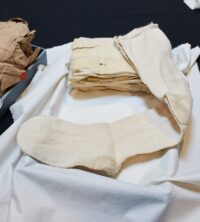 A sweater knitted 217 years ago in the Faroe Islands and still in pristine condition has been discovered in a package that was seized and impounded by the British Navy in 1807. It was opened as part of the Prize Papers Project which is working to catalogue and digitize the huge quantity of documents, including 160,000 undelivered letters, in the UK’s National Archives captured by the Royal Navy in wars from 1652 to 1815.
A sweater knitted 217 years ago in the Faroe Islands and still in pristine condition has been discovered in a package that was seized and impounded by the British Navy in 1807. It was opened as part of the Prize Papers Project which is working to catalogue and digitize the huge quantity of documents, including 160,000 undelivered letters, in the UK’s National Archives captured by the Royal Navy in wars from 1652 to 1815.
The sweater was made of fine wool in a pattern of tiny black and white florals against a vivid red background. The pattern, fitted waist, short length, half-sleeves and open neckline is very similar to the jumper of the Faroese national dress. It was sent by one Niels C. Winther of Tórshavn to Mr P Ladsen in Copenhagen with an accompanying note written in Danish stating “my wife sends her regards, thank you for the pudding rice. She sends your fiancé this sweater and hopes that it is not displeasing to her.” He described it as a “sweater for sleeping.”
Margretha Nónklett [head of ethnology at the Faroe Islands national museum] said: ‘This is a tremendously exciting find. There are very few pieces like this and we have none with this particular design. It would have been handmade at home with hand-dyed wool.’
Dr Amanda Bevan, of the National Archives, said: ’This is a rare example of a parcel surviving in the Prize Papers, which often contain letters consigned to ships for delivery by sea.’
The Winthers’ parcel sailed from Tórshavn aboard the cargo ship Anne Marie, one of two ships owned by the King of Denmark that had the monopoly of trade with the Faroes, on August 20th, 1807. The news had not yet reached the islands that the British Navy had begun the Second Battle of Copenhagen four days earlier. The British engaged in the naval battle and bombardment of Copenhagen in the attempt to seize or destroy the Danish fleet before the Danish king succumbed to French pressure to join forces with Napoleon. If neutral Denmark was swayed to the French side, the British feared its navy would their vital military and commercial access to the Baltic Sea.
 The Anne Marie was boarded by the crew of the HMS Defense off the coast of Norway on September 2nd. Captain Jurgen S Toxsvaerd and the rest of the Anne Marie‘s crew were imprisoned and the mail and cargo it was carrying seized. The battle raged until September 7th when the Danish fleet surrendered to the Royal Navy. Toxsvaerd was later released in Copenhagen. He reported the Anne Marie’s seized cargo as “49,000 pairs of woollen stockings, eight tons of dried fish, 100 cases of candles, 250 barrels of tallow, 19 barrels of train oil and 10 barrels of feather.”
The Anne Marie was boarded by the crew of the HMS Defense off the coast of Norway on September 2nd. Captain Jurgen S Toxsvaerd and the rest of the Anne Marie‘s crew were imprisoned and the mail and cargo it was carrying seized. The battle raged until September 7th when the Danish fleet surrendered to the Royal Navy. Toxsvaerd was later released in Copenhagen. He reported the Anne Marie’s seized cargo as “49,000 pairs of woollen stockings, eight tons of dried fish, 100 cases of candles, 250 barrels of tallow, 19 barrels of train oil and 10 barrels of feather.”
A handful of those woollen stocking in Toxsvaerd’s report were found in another shipment opened at the National Archives. The parcel contained a bundle of finely knitted women’s knee-length stockings and some fabric samples. Fine woollen stockings were a top export from the Faroe Islands during this period.
Paper rix-dollars were also found among the letters, with a wad of them wrapped around 18 silver coins, which include Danish skillings dating back to the reign of Frederick III of Denmark, 1648-1670.
There are also two samples of barley being returned to sender with a note complaining about the quality of an earlier shipment: ’Out of 416 barrels of grain sent, 399 have taken some damage’. 25 barrels were so bad they couldn’t sell them, they wrote.
All of the letters and photographs of package contents from the Anne Marie will be digitized and made available in the Prize Papers database. The project is immense in scope with an estimated 3.5 million document images to be digitized and made freely available online. It will take two decades to complete.
If a descendent of Mr. P. Larsen or his unnamed fiancé were to come forward now, would they be able to claim the lovely sweater?
At first glance, I’d say they wouldn’t have a case, legally speaking, because Britain claimed the contents of captured ships as Prize based on a treaty agreed upon by all belligerent parties. I am very far from a lawyer, however, and I have no idea what arguments could be made in a court today on behalf of private parties rather than governments. I’d love to see the Larsen descendants stake a claim!
I was under the impression that prize law governed the seizure of government property, not the private property of individuals, with the exception of cargo that could be argued to be of aid to the enemy war effort.
A naval ship, owned by the government, could of course be seized. Any government owned cargo as well. Private cargo of obvious aid to war effort likewise could be seized – shipments of grain, iron, gunpowder, uniforms, etc. But you could not, as far as I know, seize the personal effects of the common sailor or passenger on the ship.
You could, of course, jail enemy combatants on military ships – and perhaps, in so doing, confiscate their personal effects, depending on circumstances. But I would be shocked if the seamen manning a private merchant vessel could be imprisoned simply for manning a ship carrying cantraband; or could be robbed of their own private property, such as coinpurses, jewelry, clothing, etc.
I think the question would probably hinge on the legal status of the mail the ship was carrying. It may well be that even if both the sender and the recipient were civilians, by entrusting the parcel to a ship owned by the King, the parcel became a valid target for seizure, as it was in the custody of the crown, and the Danish monarchy would therefor be responsible for any loss or damages incurred.
In fact, it’s possible that Winther and Larsen sought, and received, restitution for said loss from the crown – the same way you might seek reimbursement today if a parcel company lost or destroyed your package.
Dear History Blog, following up on this story of the knitted jumper send from Faroe Island to Denmark back in 1807. I just wanted to let you know that Niels Christoffer Winther, born in Torshavn on the Faroe Islands in November 1776, was my great, great, great, great grandfather. Thank you for bringing this great story to the attention of my family and me.
Kind regards, AM Winther